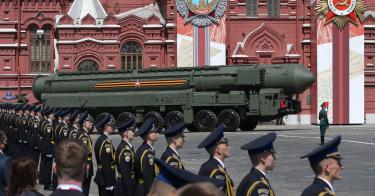Russian President Vladimir Putin continues to rattle his nuclear saber loudly. In the run-up to his invasion of Ukraine, he ordered his nuclear weapons on “special alert status” and has since threatened more than once to use them.
As a result, Moscow’s arsenal of over 2,000 tactical nuclear weapons is now in the spotlight. Policymakers and experts take to the national media daily to debate the likelihood that Russia will use them against Ukraine or even NATO. Compared to a month ago, the nation is much better informed about Russia’s nuclear doctrine of “escalate-to-deescalate,” by which Moscow reserves the option to use one of these low-yield, battlefield nuclear weapons during a conflict in Europe to compel the enemy to back down.
What is President Biden’s response to all this? Incredibly, he has opted to eliminate a program that would deliver a nuclear missile designed to deter Russia from exercising that very option.
In 2018, the Trump administration proposed developing a nuclear-armed, sea-launched cruise missile to discourage our adversaries from using their tactical nukes. Earlier this year, Congress appropriated over $5 million for this program.
>>> Putin’s Nuclear Threats Against Ukraine Demand a NATO Response
Monday the Biden administration abruptly canceled the program, offering no justification for the action.
The danger is that while Russia possesses thousands of these tactical nuclear weapons, the U.S. has only about 100 of them stationed in Europe. The disparity is even more acute in the Indo-Pacific, where China deploys hundreds of nuclear-capable missiles that can strike U.S. bases and allies in the region, and the United States deploys zero.
Moscow and Beijing may easily interpret this gap in tactical nuclear weapons to suggest the U.S. lacks a credible nuclear deterrent at the lower levels of the escalation ladder.
The sea-launched cruise missile was proposed to address this growing gap. The missile is designed to be carried by attack submarines that could be deployed directly to European or Indo-Pacific waters.
Because it could be deployed close to conflict, rather than on strategic ballistic missile submarines that remain far out at sea, this missile would help remove any Russian or Chinese misperception that the U.S. would not be able to retaliate in kind against a limited nuclear strike.
Forgoing this capability would deprive the U.S. of a critical deterrent to the type of nuclear attack that we are currently worried about in Europe. As Putin threatens Europe and NATO with nuclear weapons, Biden’s decision to axe the program sends a dangerous signal that Putin’s threats are working, and that the United States is being deterred.
This move also telegraphs weakness to our allies, who rely on the U.S. nuclear umbrella for their security. Canceling the development of a gap-filling weapon that would be deployed to help protect them may now cause them to question U.S. assurances.
>>> Putin’s Dangerous Nuclear Brinkmanship in Ukraine
It has been no secret that Biden desires to reduce the role of nuclear weapons in U.S. strategy. Eliminating this nuclear capability signals his commitment to that goal. But this decision completely ignores the reality of the nuclear threats we are facing today. When it comes to national security, political promises cannot take priority.
In fact, given Russia’s nuclear threats, not to mention China’s massive nuclear expansion, the Administration should be asking what more we need to add to our nuclear arsenal, not what can be cut.
Now it is up to Congress to reverse the president’s decision and provide the funding needed to accelerate the sea-launched cruise missile in its upcoming appropriations cycle. Nuclear weapons are no longer a concern of the past, as much as we may wish that to be so. Despite Biden’s ill-considered policy, Congress can right the ship.
This piece originally appeared in 19fortyfive



